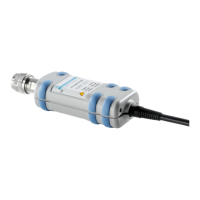Remote Control - Commands R&S NRP-Z11/21/31/41/61/211/221
1137.7470.12 6.12 E-7
<sensor_function> Description of the measurement mode
"POWer:BURSt:AVG"
Burst Average
This mode is used to measure the average power of bursts. The time interval in which the average
power is measured starts when the power exceeds the trigger threshold and stops when the trigger
logic detects the end of the pulse. To prevent power drops due to modulation from being erroneously
interpreted as the end of a pulse, the user must define the dropout tolerance with
SENSe:POWer:BURSt:DTOLerance.
To minimize noise and zero offset, the measurement is performed with chopper stabilization. The
polarity of the detector output signal is therefore reversed from burst to burst. By subsequently taking
the difference of the output signals, the effect of the video path on noise and zero drift is minimized.
In the Burst Average mode, only internal trigger events (from the signal) are evaluated (irrespective of
the setting of the TRIGger:SOURce parameter). The TRIGger:DELay parameter is also ignored, so
that the measurement interval begins exactly when the signal exceeds the trigger threshold.
Time intervals that are to be excluded from the measurement can be set at the beginning and at the
end of the measurement interval (see commands SENSe:TIMing:EXCLude:STARt and
SENSe:TIMing:EXCLude:STOP).
"XTIMe:POWer"
Trace
In the Trace mode, the envelope power can be recorded as a function to time. This is done by
sampling power over a time interval that can be specified by the user (SENSe:TRACe:OFFSet:TIME
and SENSe:TRACe:TIME commands), and then assigning the power values that have been
determined to a number of pixels that are largely user-selectable (SENSe:TRACe:POINts command).
The time interval represented by a pixel is obtained by dividing the trace length by N-1, where N is the
number of pixels.
In the simplest case, each pixel is assigned a single sampling value which fully characterizes it. If
several sampling values are assigned to a pixel, the average power is made available for the time
interval in question.
In the SENSe:TRACe:REALtime ON setting (realtime processing), the measurement is performed
without chopper stabilization, i.e. a measurement consists of a single sampling sequence activated by
a trigger event, independent of the setting of the averaging filter. Otherwise a second sampling
sequence with reversed polarity of the detector output voltage is recorded, and the difference of the
measured values of the two sampling sequences is determined for each pixel. This suppresses low-
frequency noise and increases the measurement accuracy for the average power of the individual
pixels. The averaging factor determines how often the cycle is repeated.
Time intervals that are excluded from the measurement can be set at the beginning and the end of the
sampling window or timeslot in the measurement modes Burst Average and Timeslot Average.
(SENSe:TIMing:EXCLude:STARt and -:STOP).
The query yields
• 1 for "POWer:AVG",
• 2 for "POWer:TSLot:AVG",
• 4 for "POWer:BURSt:AVG",
• 8 for "XTIMe:POWer".
Default setting: "POWer:AVG"
SENSe:POWer:AVG:APERture[?] 10.0e–6 to 0.3
SENSe:POWer:AVG:APERture defines the time interval (sampling window) for the Continuous Average
mode; measured values are continuously recorded in this interval. In manual operation, the default
setting of 20 ms in conjunction with the activated smoothing is sufficient in most cases.
Larger sampling windows are needed when the measurement shows fluctuations due to modulation. It
is then useful to adapt the size of the sampling window exactly to the modulation period, which yields
an optimally stable display. If the modulation period varies or is not precisely known, the Smoothing
function should also be activated (see command group SENSe:POWer:AVG:SMOothing). With
smoothing activated, approx. 5 periods within a sampling window are sufficient to reduce the
fluctuations caused by modulation to an acceptable degree; fluctuations are no longer perceptible with

